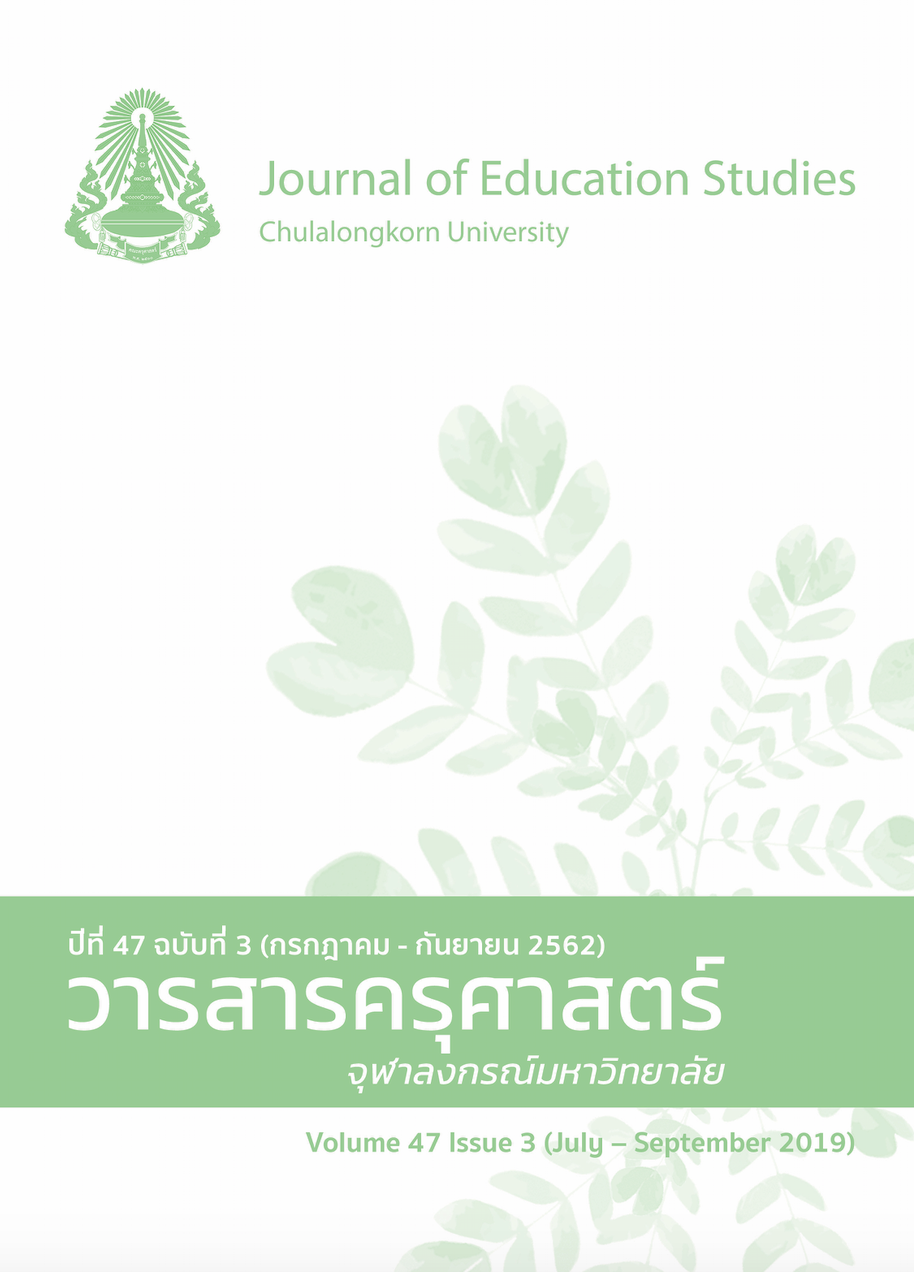A Study of Effects of Organizing Field Trip in Art Activities on Aesthetic Development of Primary School Students
Keywords:
FIELD TRIPS WITH ART OUTDOOR ACTIVITIES, AESTHETICS, PRIMARY SCHOOL STUDENTSAbstract
This is a quasi-experimental research which aims to 1) study and improve the organization of field trips with outdoor art activities to better develop aesthetics among primary school students, 2) to study the results from the organized field trips with outdoor art activities on the aesthetic development of primary school students, and to 3) to explore opinions of students about organized field trips with outdoor art activities. The sample was 25 Prathomsuksa 4, or 4th-grade, students who attended the art learning program at Chulalongkorn University Demonstration Elementary School. The participants carried out 6 art field trip activities. The experimental plan implemented in this study was a One Group Pretest–Posttest Design. The research instruments included 1) 7 lesson plans for art activities, 2) 6 recording forms for the organization of art field trip activities, 3) an aesthetics test,
4) guidelines for analyzing aesthetic expression, 5) an observation form for aesthetic expression, 6) a an observation form for aesthetic experiences; 6) a questionnaire to obtain the students’ opinions concerning the organization of field trips and outdoor art activities, and 7) a questionnaire on the students’ background knowledge and experience in art. The data were analyzed using a rating scale, percentage, mean, standard deviation, and the t-test was also utilized to compare and contrast the data being analyzed at the significant difference level of .05.
The results were as follows: 1) the organization of outdoor art activities targeting the students’ aesthetic development led to 6 major aesthetic development activities; 2) the mean of the students’ aesthetic development score rose after they participated in the outdoor activities (M = 3.70), compared to the mean before engaging in the activities (M = 1.91) at the level of .05; and 3) the students agreed most strongly on having the outdoor art activities, with the most enjoyable activity being Activity 2, accounting for 36%, and the activity making the biggest impression being Activity 4.
References
ภาษาไทย
คนึงหา สุภานันท์. (2544). ความคิดเห็นของครูศิลปศึกษาเกี่ยวกับกิจกรรมการเรียนการสอน วิชาศิลปศึกษาตามทฤษฎี DBAE ในหลักสูตรมัธยมศึกษาตอนต้นพุทธศักราช 2521 (ฉบับปรับปรุง พ.ศ. 2533) ในโรงเรียนมัธยมศึกษา สังกัดกรมสามัญศึกษา กรุงเทพมหานคร (วิทยานิพนธ์ปริญญามหาบัณฑิต ไม่ได้ตีพิมพ์). จุฬาลงกรณ์มหาวิทยาลัย, กรุงเทพฯ.
คำรณ หลำเจริญสุข. (2540). ความคิดเห็นของครูศิลปศึกษาเกี่ยวกับการสอนศิลปศึกษาในโรงเรียนประถมศึกษา สังกัดกรุงเทพมหานคร (วิทยานิพนธ์ปริญญามหาบัณฑิต ไม่ได้ตีพิมพ์). จุฬาลงกรณ์มหาวิทยาลัย, กรุงเทพฯ.
ชุติมา เวทการ. (2551). การจัดการเรียนรู้สาระทัศนศิลป์บนพื้นฐานวัฒนธรรมชุมชน. กรุงเทพฯ: สำนักพิมพ์แห่งจุฬาลงกรณ์มหาวิทยาลัย.
ธาริน กลิ่นเกษร. (2554). ผลของการส่งเสริมประสบการณ์ทางสุนทรียะผ่านกิจกรรมในพิพิธภัณฑ์ศิลปะที่มีต่อสุนทรียภาพของนักเรียนประถมศึกษา (วิทยานิพนธ์ปริญญามหาบัณฑิต ไม่ได้ตีพิมพ์).
จุฬาลงกรณ์มหาวิทยาลัย, กรุงเทพฯ.
เนาวนิตย์ สงคราม. (2557). การศึกษานอกสถานที่ และการศึกษานอกสถานที่เสมือนเพื่อการเรียนรู้เชิงรุก. กรุงเทพฯ: สำนักพิมพ์แห่งจุฬาลงกรณ์มหาวิทยาลัย.
มะลิฉัตร เอื้ออานันท์. (2545). กระบวนการเรียนการสอนทัศนศิลป์ในระดับประถมศึกษาสำหรับครูยุคใหม่. กรุงเทพมหานคร: ไทยวัฒนาพานิช.
วิรุณ ตั้งเจริญ, วรรณรัตน์ ตั้งเจริญ, อำนาจ เย็นสบาย, พฤทธิ์ ศุภเศรษฐศิริ, จักรพงษ์ แพทย์หลักฟ้า, และ ตรีวิทย์ วิจิตรพลากาศ (2542). การวิจัยเพื่อพัฒนารูปแบบการจัดการศึกษาสำหรับผู้มีความสามารถพิเศษด้านทัศนศิลป์: กรณีศึกษาโรงเรียนไผทอุดมศึกษา. กรุงเทพฯ: สำนักงานคณะกรรมการการศึกษาแห่งชาติ.
ศิริวัฒน์ แสนเสริม. (2543). ความคิดเห็นของผู้บริหาร ผู้เชี่ยวชาญทางพิพิธภัณฑ์ศิลปะและนักวิชาการศิลปศึกษาเกี่ยวกับบทบาททางการศึกษาของพิพิธภัณฑ์ศิลปะในประเทศไทย. (วิทยานิพนธ์ปริญญามหาบัณฑิต). จุฬาลงกรณ์มหาวิทยาลัย, กรุงเทพฯ.
อำไพ ตีรณสาร. (2543). วิธีการสอนศิลปศึกษา. สืบค้นจาก https://pioneer.netserv.chula.ac.th/~tampai1/ampai/cont3.htm
ภาษาอังกฤษ
D’Onofrio, A. & Nodine C. F. (1981). Children’s responses to painting. Studies in Art Education, 20(1), 14-23.
Edgar, D. (1969). Audiovisual methods in teaching. NY: Dryden Press.
Efland, A. D. (1979). Conceptions of teaching in art education. Art Education, 32(4), 21-33.
Mittler, G. A. (1986). Art in focus. Peoria, IL: Bennett & Mcknight.
Parson, M. J. (1987). How we understand art: A cognitive developmental account of aesthetic experience. New York: Cambridge University Press.
Tishman, S. (2006b). Five design elements of active learning experiences in art museums. Retrieved from https://www.cct.umb.edu/artmuseum.html




